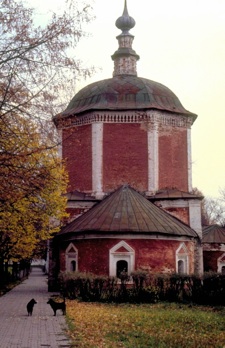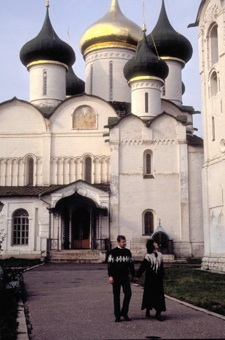USSR 1991
USSR 1991

USSR 1991

Suzdal is a magical, almost fairy-tale little town with only 12,000 people. It is totally enchanting, and I have really enjoyed my time here today.
Like most other days, I woke up early this morning – this time at 6:15am. The overnight rain had cleared, although it was still overcast. I decided to make the most of it and go for a long walk as breakfast was not scheduled until 9:00am. So I headed off from the tourist complex where we are staying over a small bridge nearby that crosses the River Kamenka, and then along some back streets with beautiful little houses with carved facades, past the convent (where we will be dining tonight) and up the hill into the town.
Suzdal is a mass of Russian Orthodox churches with their distinctive onion-shaped domes. It is a quiet town, with almost every house having a yard, every square centimetre of which is under vegetable cultivation. The town is especially pretty in its autumn colours, and as the whole town is under a state preservation order for its historic importance, it is abnormally well maintained.
It was wonderful to have a couple of hours to explore on my own, to enjoy the peace of the early morning in this quiet little Russian town, to take the time composing photos of the picturesque surroundings without being hurried, and to able to absorb the exquisite surroundings. After my time this morning, I really feel I come to know the layout of this town. I completed a full circuit of the town, including walking along parts of the remains of the earth ramparts around the oldest part of town, and even across the floodplain through a herd of cows at one stage – it was a good opportunity to get really close to the sticky black soil that forms the basis of the district’s agriculture. I made it back for breakfast with ten minutes to spare just as the heavy rain started falling.
The organised tour of Suzdal that we had this morning was a totally different, though equally worthwhile experience. We began with a visit to the Museum of Wooden Architecture which I had seen from the outside during my walk but had not entered. The museum is a fairly small group of old, traditional wooden buildings from the surrounding area which have been disassembled, brought together and re-built in the town. The centrepiece is a beautiful wooden church, or rather two churches, as in this part of Russia they traditionally use a smaller building which is easier to warm up for winter services, the heat simply coming from the bodies of the assembled congregation. During summer, the museum has working displays of spinning thread and using a tread water wheel, but the “off season” began on 1st October, and so we missed out on these displays by just three days.
Next we walked across the river (using the bridge!) to the Suzdal Kremlin (“kremlin” means fortress), a spectacular collection of white buildings whose centrepiece is a cathedral with blue onion domes topped with gold stars. As we approached, the sun shone for its one and only time today, and it looked magnificent. We went inside a room to learn something of the history and significance of icons in the Russian orthodox Church, and then into the cathedral itself which is “neither open nor closed” – which means it remains consecrated but regular services are not held there. For that reason, it was permitted to take photos inside with permission (and a 10 rouble fee) – normally photography of the ornate interiors of Russian Orthodox churches is forbidden.
From the Kremlin we travelled to one of Suzdal’s largest complexes, the Saviour Monastery of St Euthymius. This complex is surrounded by a high, fortress-like wall, and it overlooks the river below and the convent on the other side of the river. Its buildings were quite magnificent, but the highlight of the visit was hearing a performance of bell ringing from the huge belfry tower housing 17 bells. In the atmosphere of the monastery, with its old buildings, lovely gardens and birds flying around (only crows, but birds nonetheless), the effect was magical.
After a short visit to a house whose interior has been restored to its original 1700 appearance, we had lunch to the accompaniment of a piano accordionist/ singer. Following lunch, we visited the Experimental Agricultural Research Station that is located in Suzdal, known formally as the Vladimir Regional State Experimental Station (владимирская областная государст-венная опытная станция). We did not get to see any of the farming because it had started raining quite heavily by the time our detailed briefing by the Director, Valentin Krotov (валентин григорьевич Кротов), finally concluded. Still, I was able to make 15 pages of notes on Soviet agriculture from Director Krotov’s presentation, which was entertaining, humorous and informative. He was especially proud of a substance that his son (who works there) had invented called (I think) hydro-heli. It is an organic substance which is intended to be mixed with soil. It absorbs water and then releases it slowly over a long period of time, removing the need to water frequently in greenhouses. He placed a few crystals in the bottom of a glass and they absorbed the entire glass full of water. It was quite something to see, and I would have loved to get a sample to try on our pot plants at home.
It seems that the rain has well and truly set in now, and it might last for a few days. Today’s maximum temperature was 17°C, and the forecast for tomorrow is only 14°C – quite a contrast to the 25°C we experienced on 1st October, which was Moscow’s hottest October day for over 100 years (as I was told today) – and that was the day we visited the school and they couldn’t turn off the central heating.
It is interesting to see the way that private enterprise is starting to take off here. Everywhere we go as visitors there is a crowd of young men with black attaché cases waiting to sell us something or other. Some of them must be making a fair income from it – one fellow in particular followed us around in his car (a fairly new, shiny Lada) and was there waiting for us each time we stopped, with the same things available from the same black attaché case.
However, these young salesmen are invariably polite and even generous, throwing in a small present of a calendar, or postcards, or something when a purchase is made. I do hope that such “niceness” doesn’t disappear as capitalism takes hold, as seems inevitable now.

Day 6
Suzdal, Russia, USSR
Thursday
3 October 1991














